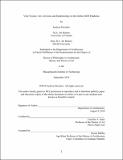| dc.contributor.author | Davidow, Jackson
(Jackson Struthers),
1990- | en_US |
| dc.contributor.other | Massachusetts Institute of Technology. Department of Architecture. | en_US |
| dc.date.accessioned | 2020-10-18T21:30:46Z | |
| dc.date.available | 2020-10-18T21:30:46Z | |
| dc.date.copyright | 2019 | en_US |
| dc.date.issued | 2019 | en_US |
| dc.identifier.uri | https://hdl.handle.net/1721.1/128063 | en_US |
| dc.description | This electronic version was submitted by the student author. The certified thesis is available in the Institute Archives and Special Collections. | en_US |
| dc.description | Thesis: Ph. D. in History and Theory of Art, Massachusetts Institute of Technology, Department of Architecture, May, 2019 | en_US |
| dc.description | Cataloged from PDF version of thesis. Images from pages 324 to 374 are redacted. | en_US |
| dc.description | Includes bibliographical references (pages 295-323). | en_US |
| dc.description.abstract | Most histories of HIV/AIDS, art, and cultural activism pivot around New York and are confined to the American context. Instead, this dissertation maps out a more expansive transnational Anglophone network of individuals, projects, and coalitions that conceived of the virus as a global problem during the 1980s and 1990s. Methodologically combining archival research with oral history interviews, this study proposes and models an epidemiological approach to art history that tracks and theorizes significant patterns of viral propagation, activist response, and visual culture-making across groups in Canada, the United Kingdom, South Africa, and the United States. Each chapter focuses on artists, activists, and critics--many of whom were queer, women, and people of color--as they formed communities in which the virus generated local, national, and global discourses and practices of cultural activism. Structured around four historical case-studies in and across Toronto, London, Cape Town, Johannesburg, and Boston, this dissertation encompasses a diverse cultural archive cutting across media and aesthetic forms: visual artworks, films, exhibitions, texts, protests, workshops, campaigns, festivals, and nightlife. Ultimately, this dissertation argues that transnational AIDS cultural activism, with its viral aesthetic strategies, emergent modes of identification, and bold political interventions in public space, produced new critical understandings of postmodernism, queerness, globalization, and postcoloniality. | en_US |
| dc.description.statementofresponsibility | by Jackson Davidow. | en_US |
| dc.format.extent | 374 pages | en_US |
| dc.language.iso | eng | en_US |
| dc.publisher | Massachusetts Institute of Technology | en_US |
| dc.rights | MIT theses may be protected by copyright. Please reuse MIT thesis content according to the MIT Libraries Permissions Policy, which is available through the URL provided. | en_US |
| dc.rights.uri | http://dspace.mit.edu/handle/1721.1/7582 | en_US |
| dc.subject | Architecture. | en_US |
| dc.title | Viral visions : art, activism, and epidemiology in the global AIDS pandemic | en_US |
| dc.title.alternative | Art, activism, and epidemiology in the global AIDS pandemic | en_US |
| dc.type | Thesis | en_US |
| dc.description.degree | Ph. D. in History and Theory of Art | en_US |
| dc.contributor.department | Massachusetts Institute of Technology. Department of Architecture | en_US |
| dc.identifier.oclc | 1199073116 | en_US |
| dc.description.collection | Ph. D. in History and Theory of Art Massachusetts Institute of Technology, Department of Architecture | en_US |
| dspace.imported | 2023-03-08T20:25:34Z | en_US |
